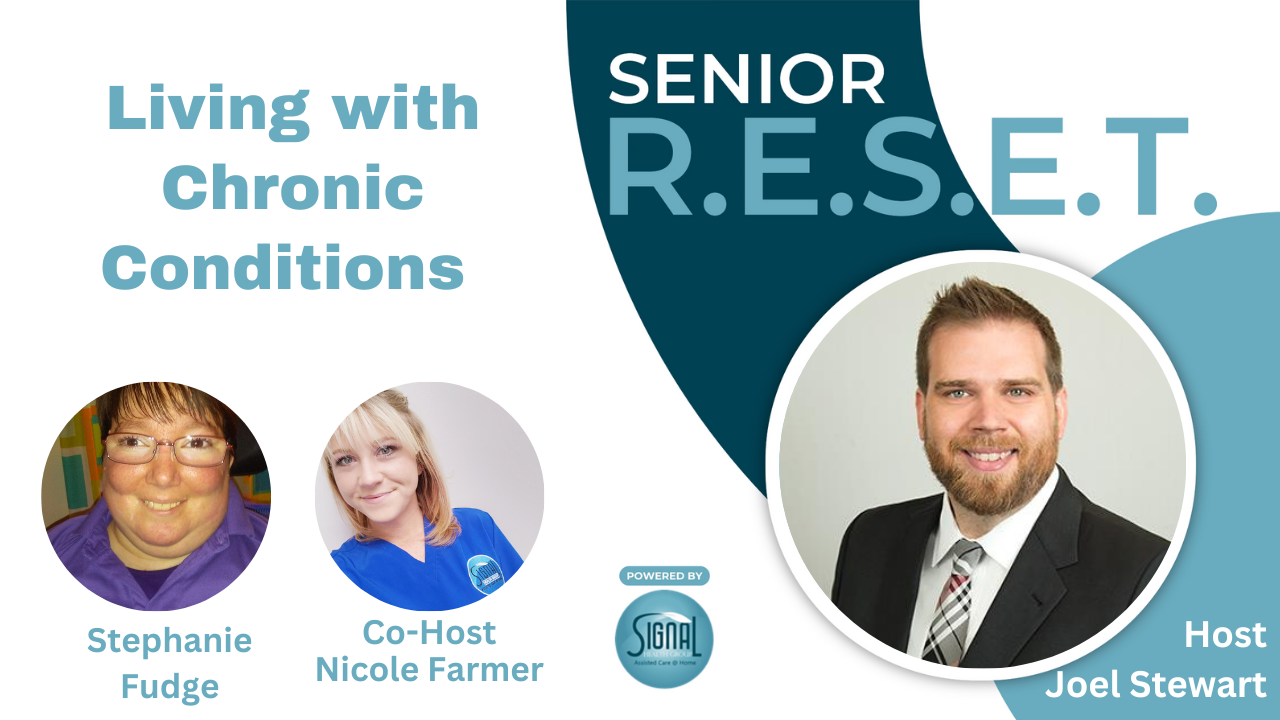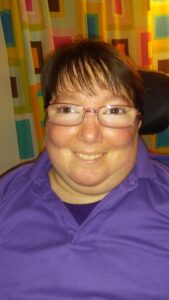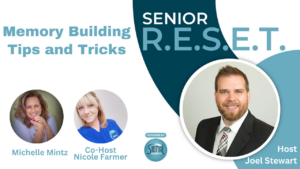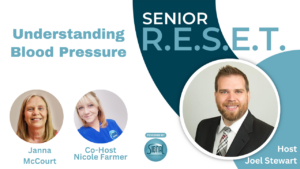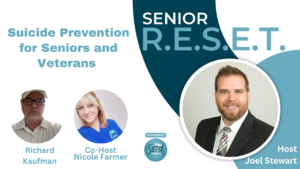Watch Here
Lady T and Stephanie Fudge join us to talk about living with chronic health conditions. Lady T shares her journey with cancer and living with the aftermath of chemotherapy. Stephanie Fudge shares her story of living with CP and the struggle to become independent.
Highlights:
{01:03} Lady T’s journey with cancer
{08:06} Stephanie’s journey with CP
{13:13} The steps to independency when you have CP.
{18:04} Advocating for others with disabilities.
Listen Here
Stephanie Fudge Bio
Stephanie Fudge Bio:
Stephanie was diagnosed with Cerebral Palsy at birth and is now 41 years old. From birth, she has faced and overcome many challenges. Stephanie has gone through 42 surgeries in her lifetime. She has been living independently for the past 11 years with the assistance of caregivers and my power of attorney Nick. She now has a bachelor’s degree in general studies and uses her knowledge and experience to advocate for herself and others living with disabilities
Joel
Hey, everybody, welcome to the Senior Reset podcast. We are talking about resources, education solutions, entertainment, and training for the senior community and their families. We have a great show set up for you today.
I have Lady, T and Stephanie Fudge, and we are going to be talking about living with chronic conditions. Lady T recently fought cancer. And came through on the winning side, and Stephanie has been dealing with CP and has gone through it or has had the courage and the grit to deal with CP and move out on her own and live in independence, which is a hard thing to do.
And so, I’m going to have them basically tell a bit of their stories, and hopefully, this is something that we can all learn from and be encouraged by.
All right, so, Lady T, I’d like to just start with you. Can you just introduce yourself briefly and tell us about your story, how things are going right now, and how you’re dealing with the aftereffects of chemo and all of that?
Lady T
So, I will, and I am Lady T. Davis. I live here in Las Vegas, NV, and my journey started back in 2021. I ended up with double pneumonia for the fifth time, and they finally saw the white spots. On me. I was sent to the oncologist for the biopsy, which I used to get done in the test, and that was in October, October 31st to be exact.
On October 31st, 2021, I was in the hospital with double pneumonia. The doctors told me they were referring me to an archeologist just because they suspected multi-melanoma; they weren’t sure, but they suspected it. And so, when I was released from the hospital with pneumonia, God reassured me in November, right after that, four days after being home, he told me, It’s not unto death. He didn’t tell me what wasn’t unto death. He just said it’s not unto death.
So, I had already received reassurance from God. I was about to embark on the journey, but it wasn’t until death. And so, five months later, in April, we did the test biopsy, and it came back positive, and it was in three parts of my body. It was in the frontal lobe of my brain, the memory part, my blood, and my bones. The oncologist said that they weren’t sure if it was going to take my memory, but God said… not so, I thank God for all of his reassurance. My journey wasn’t as long as most cancer survivors. I was diagnosed with 4/26/2022 and on 10/26/2022. I was in remission.
Nicole
Wow. Wow, it’s amazing.
Lady T
So, it was nobody with God. It was also my hashtag. Now is a #butGod and #nottodaysatan.
Nicole
I love it.
Lady T
So yes, I did the chemo. I did the radiation. I still have my chest port. I had to take two shots every Friday. Every time I was doing chemo in my stomach, I was also taking chemo pills every day, seven days a week, so they had to attack my cancer—not my cancer, but the cancer… They had to attack it aggressively because of where it was, and they did not want it to continue spreading.
They got it all with all of that—the radiation, the chemo peels, the shots. I only had one hiccup that set me back, and for whatever reason, I ended up having an allergic reaction to the same thing I had. I’ve been taking it for four months, and for every reason, I ended up having an allergic reaction to it. I ended up in the hospital for four days. Work through that with God and continue on the journey.
So, as I said, that was in August, and then in October I went into remission, and I’ve been in remission since my doctor told me. He said he didn’t know if he had told me before, but he wanted me to know that I was a miracle. Because in all his years of practice, he has never seen someone recover as fast as I have. When he first diagnosed me, he asked me if I wanted the good news first or the bad news. And I said, well, I’d like to end on a positive note.
So, he gave me what he thought was bad news. So, when he said, well, it’s positive, and its multiple myelomas in three places, he told me the three places, and I said, well, that’s good news. He said OK. I don’t think you heard me; I said no. I heard you. I said, Well, what’s the good news? He said the good news is, you’re already 95% in remission. I said no. That’s called greater News. I said so You don’t have any bad news.
And so, he said, well, I’ll be right back. And I thought he walked out to go call the people with the White Jackets because I think he thought I was listening. He came back and said, did you hear anything I said? I said, Yeah, I did. I said, let me just tell you why you didn’t give me any bad news. What you did was confirm to me that it was not until death that God told me and prepared me for this journey. He just didn’t tell me what the journey was going to be. So, now I know what my journey is and what I will not be dying from.
And so, he said, well, I just need to tell you it’s treatable but not curable. I said that’s OK. I told you that it’s not curable, but with God, all things are possible. So, because you are, I said you were a part of my journey. And when your time is up, then it becomes me and God. So, right now, I’m on my journey with God. He’s doing the thing. He’s doing it within me and through me, and I’m, just as the doctor said, walking the miracle, I guess. But I have my hashtag. #butGod and that’s my story.
Nicole
I think one of my favorite things about meeting you back in April when you told us about your cancer was that it’s not my cancer, it’s the cancer. That was one of them. My favorite things you said.
Lady T
Words are powerful, and I don’t claim to have cancer. Cancer didn’t claim me; it tried to hit me, but it didn’t get to claim me. So, it’s not my cancer; it’s the cancer. It’s a journey. I’m on a journey with God. So, yeah.
Joel
One thing I will say is that when you get sick over and over, as you said, it is like the fifth time you have had double pneumonia in your lungs. It is stressful not knowing what is wrong with you. I have my own stuff, I don’t have time to get into it today. But like when there’s something wrong with you and you don’t know what it is Because it’s just wearing, you know, at that point, it’s like, almost any news is a relief because you know what it is that you’re fighting?
So, with the chemotherapy and coming out of that, I’ve heard that chemo, really can take a piece of you away, but you still seem to be in pretty good spirits. How’s it been since the chemotherapy? Dealing with you might be in intermission, but what in your mindset do you deal with to stay as upbeat as you?
Lady T
So, as I said, my hashtag is #butGod and that’s where my strength comes from. That’s where my positivity comes from. That’s where my energy comes from. It was all him. Everything I’ve been able to do Is because of him. Going through that. It was a traumatic experience, and I know my body will never be the same. Yet God is allowing me to still have the energy and strength through him to do everything that I’m able to do.
Joel
No, I think that’s a good message.
So, now, Stephanie, let’s. I’d like to hear a bit from you. Your story kind of hits close to home for me. I have close friends who have a daughter with CP, and they are not quite where you are today. They’re still all together, and she’s still not living independently. They both have college degrees. You and she have that in common. And I think that’s incredible. I’ve seen her. journey and what it’s taken to get that, and I understand how amazing it was for you.
So, I want to hear a little bit about your story and a little bit about your life because that’s also been, you know, a tough struggle, and you know, with Lady T, it was, you know, an event that caused this. You know the struggle with the chemo and are now dealing with the effects of the chemo, but for you, it’s been your whole life. I’ll turn it over to you now. I’ll stop talking. And let’s just kind of talk a little bit about, you know, where you came from and how you got to where you are now.
Stephanie
OK, I am 41. As Paul said, I have a college degree. It took me 13 years to get my college degree before I graduated college. My family and I went through some struggles, and I moved in with some roommates. through that process I decided I didn’t want to live with roommates anymore. I Wanna do this on my own.
So, one day. We were out looking for apartments… not easy to find with a disability because of all the things you have to look for, and we came to the property, and I went to get an application, and when the manager told me to take it home, she didn’t. She saw me at first because you have to do it through another song, and she told me she changed this down in the parking lot and showed me this efficiency apartment that was perfect for me because it was handicapped acceptable. And had all the things I needed. We just had to figure it out. How much? I would need and then that’s when they texted, like a caseworker. Area 9.
Now, why stream and have them help us set up home care it was the first time I was Only getting 9 hours a day. That wasn’t cutting it; it was so we switch to signal. And they made it to where I could get 12-hour care. And be mainly independent two days a week, and then I’m only by myself. At night, I went to bed. But it was a struggle.
I had many emotions throughout the whole process. At first, I was scared to death. Because I thought, what if nobody showed up? They’re not going to be stuck in bed forever. I had all these nightmares going through my head, and Sometimes I still struggle with those thoughts. But I just have to tell myself. You’ve made it this far. You can keep going.
Joel
Yeah, that’s got to take so much courage to move out on your own and have to go through that. Yeah, getting a good home care company that makes sure that you’re covered is important, but how? How long have you been living independently now?
Stephanie
It will be 11 years old in February.
Joel
11 years—that’s amazing.
Stephanie
Some days I can’t believe it myself, but then I do. Like yes, then this.
Joel
Yeah, that’s. That’s awesome. What did you have to go through to be independent? So, you said you had to, … the first step was like trying to find a place that actually could kind of adapt for your disabilities, and then you had to also line up home care through exterior companies. Did it take you a long time to figure out how this was all going to work?
Stephanie
Well, yes, because the added number of people that live with disability has a limited income, so finding an income-based apartment was the first struggle was probably worth it. In six months, to find the right one, I will fly to three different places. And a lot of them wouldn’t take me because I was so young.
Nicole
A lot of those income-based programs are geared toward people 55 and older, so They’re having trouble accepting you, yes.
Joel
And then and then you had to; you said when you initially moved out on your own, you didn’t have enough hours. What did you have to go through to try and get enough coverage?
Stephanie
You have to jump through all these hoops with a Medicaid, ridiculous process. They can’t. They had to write. I think it took two or three different things for them to finally accept.
Nicole
Now, Stephanie has a combination of hands-on, skilled hours and non-skilled waiver hours that she gets through the area of aging. So, there are two separate sources that you have to go to those approved and on the waivers.
So, you have to justify the need on both sides? One requires a doctor’s order, one does not. So, the case manager had To justify, why are you? Needing more than nine hours, and then take that to the state for approval.
Stephanie
And that’s our process. Because the state likes to do things on their own time. And I was having to call my mom in between hours and go I need to go to the bathroom. Can you come? Well, then she would get frustrated. And I would get frustrated. It was just a process. At one point she looked at me, so we need to figure this out. You’re going to have to go to a nursing home. And I was like, Oh, hell no. We don’t say those words.
Joel
So how many hours do you have now with the combination of Medicaid and Medicare?
Stephanie
I get 84 hours out of a week, which is 12 hours a day. Or 8 hours of skilled and 4 hours of non-skilled
Joel
So, to develop that plan, was it the local So you know, we went over this in some previous podcast episodes, but the local area of aging is different in every state. They’re called different things, and in Stephanie’s area, it’s called the lifestream. They’re nonprofit organizations that are going to help you figure it out.
So, were they able to help you come up with this kind of two-tiered structure? Or was it working with the signal, or was it a combination of the two working together?
Stephanie
It was a combination of the two.
Nicole
Yeah, we work hand in hand at signaling with the caregivers because you have to apply for those separately. So, we have to figure out who’s going to give us these many hours and how many hours they typically want us to get from skilled services, from traditional Medicaid, and then supplement those hours on the non-skilled side. So, you have to kind of play a game of balancing, figuring out who’s going to give you more hours. And where are you going to get the rest of them to fill them in?
Joel
Got it. And just because I’m a horrible host and I didn’t say this before, that is my co-host, Nicole Farmer. She’s the director of Signal Health Group Indiana, and she’s helping Stephanie today on-site. So that’s why…
Nicole
And I went to school with Stephanie. I’ve known her since kindergarten. And I think she’s amazing.
Joel
BFS right here.
Nicole
Yeah, she, you know, her degree… We mentioned that she had a college degree, and it may have taken her thirteen years, but she got that degree in general studies, and she uses that to advocate for herself and for others that struggle with disabilities as she has. So, I think that’s pretty amazing.
Stephanie
Thank you.
Joel
Yeah, what do you want to tell us a little bit about that? You know, I told you some when we talked the other day. But what do you do for advocacy?
Stephanie
I’ve advocated for more housing for people with disabilities.
I have a certificate. In the state of Indiana, it was called Partners and Policymaking. “We met with legislators, and they taught us how to write bills. And things to get the things we need to accomplish. I work with the Independent Living Center will increase. Break in support care. Well, it’s so fraught. Where are you going to hire your caregivers They’re trying to get out of them. I’ve got hope for that. And basically, this is for myself to make sure I get everything I need. While helping others at the same time.
Nicole
To speak up when you meet things and not try to keep that quiet. That was a bit of a struggle.
Joel
And you also do something for Signal Health Group, I’ve heard.
Nicole
She’s, our model. So, when we have people that need to be checked off for their skilled training, we use Stephanie because their level of care is high enough that they can kind of see everything, you know, from Hoyer lifts to bathing, so all the things that she needs but she likes to try to scope them out. She likes that. So, she likes it.
Joel
What do you look for in a caregiver when you’re scoping him out?
Stephanie
As long as they know how to use the wire, and If they act like they care. That’s all I look for. I mean, you have to work with somebody. And get to know them. Before you know if it’s a good fit or not, you leave. First impressions tell you a lot.
Nicole
Yeah, matching caregivers to clients can be a bit of a challenge, and it doesn’t always speak to the caregiver.
Joel
That’s so.
Nicole
Sometimes there’s just a personality conflict, or they’re just not as comfortable as they need to be. So, Stephanie likes to take first dibs on the ones that she likes. Oh, I think they’ll be. She’s pretty good read if it’s going to be a good fit for her in the beginning.
Stephanie
I’ve had to go through quite a few until I got Good at picking them out. Right fit.
Joel
Do you think that trying to spot the ones that seem like they authentically care is kind of the key?
Stephanie
Because if they’re your paycheck, you’re not going to get the kind of care you deserve.
Nicole
And she has an amazing one now. Pretty much puts up with her for seven days a week and likes it. Yes, they have family Thanksgiving, sometimes together. The caregivers come out here. So, if they do genuinely care, like she’s found some good,
Stephanie
I went to school; actually, my sister went to school with me. One I have now. So, I know what I have now. They were 13; they’ll both be 36. On the same day, but yeah.
Nicole
There’s a good one.
Joel
So, what kind of You know, you said that your biggest fear is that someone doesn’t show up and you’re just kind of left on your back with no one to help you. I know that you have the Hoyer lift to help you get around and that you have caregivers to come in, and when we talked last week, you mentioned that you had a life alert button. If there was something that was an emergency, you could use that. You know what kind of adaptations you have to try to safeguard and keep those kinds of worst-case scenarios from coming true.
Stephanie
I haven’t set it up to wear my cell phone. If I was on my bed. Also, I can call whomever I need. I have. I’ll find that I can push. That’ll open my front door if I need it. So, if I’m here by myself and I’m up and the fire alarm goes off, I can hit the button and still get out, stuff like that. And then I have an awesome POA to make sure get all my medicines. They get the white boxes, and He pretty much fills in if I need help in the area.
Nicole
And he keeps her independent, too. He makes her do things for herself and keeps her very strong and independent, yes.
Joel
So, after 11 years, do you regret the decision to go through all of the hurdles and face all the fears of living on your own?
Stephanie
No, I do not. I’m glad I made this decision to try and didn’t give up.
Joel
Do you have a message for other people out there dealing with CP or other chronic conditions where maybe they could live independently, but the hurdles seem so big? Do you have a message for them?
Stephanie
To be patient and work through the rules, and if it’s meant to be, it’ll happen.
Joel
The good message All right. Do you have anything you would like to add? Or if Lady T wants to add anything. Or ask anything.
Lady T
I would like to give Stephanie a hashtag #Ican.
Stephanie
I like that.
Nicole
Yeah, that’s cool. You’re so awesome, lady.
Joel
I remember, you know, going through some stuff myself where I had trouble getting around for a couple of Years when I came through on the other side, you knew my motto was that once you face disabilities, you can’t look at the things that you can’t do anymore.
And for Stephanie. She’s dealt with it her whole life. And so, for her, it’s all about looking at the opportunities. But for people that you know, maybe something happened later on in life that made it so they could do less than they used to be able to do. I mean, aging does that’s natural too, but what’s the goal? Is you look at all the stuff that you can no longer do, that’s just a path to depression and darkness.
But there are always things that you can still do, and that’s what you have to focus on—not the stuff you can’t do anymore, but the stuff that you can still be capable of doing, we’re all kind of on this one-track path that leads from birth to death, and we’re not equally capable at all parts of that. path, and so the goal is to keep your future focused, look at what you can do, and focus on that stuff.
And I honestly think stories like these are inspiring. You know, facing down cancer, you know, looking at, like, growing up and dealing with something like CP or your whole life and still getting out there and working with legislators to pass legislation helping our, you know, in-home care group vet their caregivers, you know, keeping that independence, even though it’s so easy. The easy route is to give it up. But you know, it’s just very inspiring stories focusing on what you can do and then reaching for it.
Nicole
Yeah, and I think the stories are very inspirational and amazing, but one of the things that I find most amazing about both of you ladies is your desire and your ability to encourage others. I mean, I met Lady T one time in Vegas, and I know someone struggling with cancer, and I gave her Lady T’s number, and she texted her encouraging words.
It’s like she doesn’t even know her. She’s never met her. I just told her. Her story when we were in Vegas and she asked if it was OK, and she’s been reaching out to her and Stephanie to be able to advocate for other people, build them up, and show them that they can do this too. I think that’s, I mean, the fact that you guys just keep going and keep moving. And don’t let it stop you. That’s great in itself, but your desire to want to build other people up through that is the part that amazes me the most.
Joel
Well, thank you, everybody. Thank you for your time, which I hope you have. Have a great day.
Stephanie
You are too. Thanks, guys.

